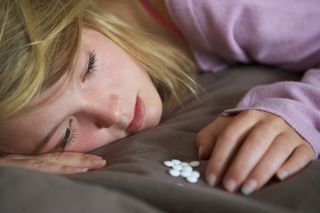3 New Dangerous Drug Habits in Teens

It's well-known that teens experiment with illegal substances such as alcohol and marijuana. But recently, children and teens have turned their attention to substances found at home or local convenience stores. They're abusing parents' prescription painkillers, energy drinks and computer cleaners.
Here are three new drug trends among kids:
Energy drinks in elementary school
In recent years, drinks that combine alcohol with caffeine, such as Four Loko, have been blamed for the deaths of teens and college students. But a new epidemic involves younger children: elementary school students are drinking highly caffeinated energy drinks to catch a buzz. Even without alcohol, these drinks are dangerous to kids' health.
"Energy drinks are gateway for elementary school kids," said Mike Gimbel, a national substance abuse educator. "They drink it like it's water. Nurses have kids coming in with heart palpitations."
Gimbel said he has also observed a growing fascination among elementary school students with caffeinated gel strips that you place on the tongue, such as ones made by the brand Sheets.
"One strip is equal to a cup of coffee, but kids are putting five or six in their mouth at once," he said. "You can overdose on caffeine by taking three or four."
Sign up for the Live Science daily newsletter now
Get the world’s most fascinating discoveries delivered straight to your inbox.
Overconsumption of caffeine, especially in young children who have smaller bodies, can cause seizures, strokes or even sudden death, according to the American Academy of Pediatrics.
Huffing Dust-Off
Huffing, or inhaling household products, is not a new phenomenon. But experts have started to see an increase in teens huffing the computer cleaner called Dust-Off, a trend that started a few years ago.
Dust-Off, sold at office supply stores, can be inhaled to produce a high lasting a few seconds to a few minutes.
"One of the attractions is that it can be felt almost immediately," said Harvey Weiss, executive director of the National Inhalant Prevention Coalition. "You don't have to wait for something to happen."
Inhalants can cause nausea, nosebleeds, impaired coordination and, in some cases, death.
According to a study from the Substance Abuse and Mental Health Services Administration, in 2010, about 2 million kids ages 12 to 17 had tried inhalants, the most popular being glue, shoe polish or toluene, a solvent.
Weiss said that parents should look to see if their children have a "sudden drop in grades, a rash around mouth or nose, a change in friends, weight loss or an odor of products on their breath."
Thirty-seven states currently regulate the sale of inhalants to minors, but many of these products are easily accessible within the home, he said.
"I hear from parents, especially those who have lost children, that they were aware of inhalants, but never imagined their kids would do them, so it wasn't discussed," Weiss said.
Pharm parties
At age 14, Brittany Gaydosh, walked into a New Year's Eve party at a friend's house, drank a couple of shots of Bacardi 151 rum, and made her way to a Ziploc bag filled with pills.
"There were Ecstasy, Xanax, Percocets, Valium and other pills in the bag that night," Gaydosh said. "I took four Ecstasy pills and a Xanax."
Throughout her teenage years, Gaydosh attended at least 20 parties like this, the now 23-year-old said. She would take handfuls of pills, wash some down with alcohol, and save the rest for later. And she's not alone. According to experts, such parties, known as "Skittles parties" (because of the brightly colored pills) or "pharm parties," have rapidly gained popularity among teens.
"At a lot of the parties, they just throw the pills on the table," Gaydosh said. "It's like candy that you can take home with you."
Teens are taking painkillers, mainly highly addictive opioids such as OxyContin and Vicodin, from medicine cabinets in their own homes, said Dr. Petros Levounis, director of the Addiction Institute of New York in Manhattan.
"They're getting these prescription pills from parents or grandparents," Levounis said. "Say I go to the dentist for a tooth extraction and I get 30 painkillers and maybe take one. My granddaughter could go into my medicine cabinet without me knowing and bring the rest of the pills to a party."
A recent report from researchers at the Centers for Disease Control and Prevention found that each year, more people die from prescription painkiller overdoses than from heroin and cocaine overdoses combined.
"Addiction to prescription opioids has become the most important problem we face," Levounis said.
Pass it on: Many teens are getting dangerous highs from drugs easily found in stores or homes.
This story was provided by MyHealthNewsDaily, a sister site to LiveScience. Follow MyHealthNewsDaily on Twitter @MyHealth_MHND. Find us on Facebook.
